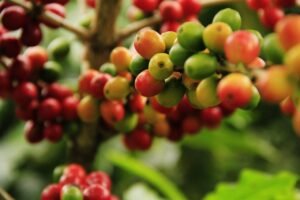Coffee lovers are always seeking ways to elevate their morning brew, and home roasting offers an exciting opportunity to take control of flavor, freshness, and creativity. Whether you’re a casual coffee drinker or a budding barista, roasting your own beans at home can transform your coffee experience. In this guide, we’ll walk you through everything you need to know to get started with home roasting, from choosing green beans to mastering the roasting process. By the end, you’ll have the confidence to experiment and create café-quality coffee in your kitchen.
Why Home Roasting? The Appeal of Freshly Roasted Coffee
Before diving into the how-to, let’s explore why home roasting has become so popular among coffee enthusiasts.
- Fresher Coffee Commercially roasted coffee often loses its peak flavor within weeks of roasting. With home roasting, you can enjoy beans at their freshest—just days after roasting.
- Cost Savings Buying green coffee beans in bulk is significantly cheaper than purchasing pre-roasted beans. Plus, you eliminate the markup from specialty coffee shops.
- Customization Home roasting allows you to experiment with roast levels (light, medium, dark) and flavor profiles. Whether you prefer fruity, floral notes or bold, chocolatey undertones, you can tailor every batch to your taste.
- Sustainability By sourcing green beans directly from ethical suppliers, you can support sustainable farming practices and reduce packaging waste.
Fun Fact: Green coffee beans can last up to a year if stored properly, giving you plenty of time to experiment without worrying about spoilage.
What You’ll Need to Get Started
Home roasting doesn’t require expensive equipment, especially when you’re just starting out. Here’s a list of essentials to kickstart your journey:
1. Green Coffee Beans
The foundation of great coffee starts with quality green beans. Look for reputable suppliers that offer single-origin options, as these allow you to explore unique flavor profiles. Popular origins include Ethiopia (fruity and floral), Colombia (balanced and nutty), and Sumatra (earthy and bold).
2. Roasting Equipment
You don’t need a fancy roaster to get started. Here are some beginner-friendly options:
- Popcorn Maker: A simple and affordable way to roast small batches.
- Skillet or Pan: Ideal for stovetop roasting.
- Air Popper: A budget-friendly option that provides consistent heat.
- Dedicated Home Roaster: For those ready to invest in precision and control.
3. Basic Tools
- Thermometer: To monitor bean temperature during roasting.
- Colander or Cooling Tray: For cooling beans quickly after roasting.
- Storage Containers: Airtight containers with one-way valves to preserve freshness.
The Basics of the Roasting Process
Roasting coffee is both an art and a science. Here’s a step-by-step breakdown of the process:
Step 1: Preheat Your Equipment
Whether you’re using a skillet, popcorn maker, or air popper, preheating ensures even heat distribution. For stovetop methods, heat your pan over medium-high heat before adding the beans.
Step 2: Add the Beans
Start with a small batch (about 100–200 grams) to practice consistency. Spread the beans evenly in your roasting tool to prevent scorching.
Step 3: Monitor the Roast
As the beans heat up, they’ll undergo several stages:
- Drying Phase: Beans lose moisture and turn yellow.
- First Crack: A popping sound signals the start of caramelization. This is where light roasts are achieved.
- Second Crack: A quieter crack indicates oils emerging, ideal for darker roasts.
Use your senses—watch for color changes and listen for cracks—to gauge the roast level.
Step 4: Cool the Beans
Once you’ve reached your desired roast level, transfer the beans to a colander or cooling tray. Stir them gently to release heat and stop the roasting process.
Step 5: Rest the Beans
Freshly roasted beans need time to degas (release CO2). Store them in an airtight container for 24–48 hours before brewing for optimal flavor.
Understanding Roast Levels
Roast level plays a crucial role in determining the flavor profile of your coffee. Here’s a quick guide:
Light Roast
- Flavor Profile: Bright, acidic, and fruity.
- Best For: Highlighting the unique characteristics of single-origin beans.
Medium Roast
- Flavor Profile: Balanced with mild acidity and hints of sweetness.
- Best For: Everyday drinking and versatile brewing methods like pour-over or drip coffee.
Dark Roast
- Flavor Profile: Bold, smoky, and rich.
- Best For: Espresso and those who prefer intense flavors.
Customization Tip: Experiment with stopping the roast at different stages (e.g., just after first crack for light roast or midway through second crack for dark roast) to discover your favorite profile.
Tips for Success
To ensure a smooth home roasting experience, keep these tips in mind:
- Start Small: Begin with inexpensive beans to practice without fear of wasting premium stock.
- Keep Notes: Document roast times, temperatures, and outcomes to refine your technique.
- Be Patient: Achieving consistency takes time, so don’t get discouraged by early mistakes.
- Ventilate Your Space: Roasting produces smoke and chaff, so work in a well-ventilated area or outdoors.
Common Beginner Questions
Q: Is home roasting difficult? A: Not at all! With basic equipment and patience, anyone can roast coffee at home.
Q: How much does it cost to start? A: You can begin with as little as $20–$30 for a skillet or popcorn maker.
Q: How long does roasted coffee stay fresh? A: Freshly roasted coffee is best consumed within 1–2 weeks for optimal flavor.
Next Steps: Dive Deeper
Once you’ve mastered the basics, explore advanced topics in our Home Roasting Adventures series:
- Choosing the Right Green Beans for Home Roasting
- Light vs. Dark Roast: How to Achieve Your Preferred Profile at Home
- Troubleshooting Common Issues When Roasting Your Own Coffee
Each article builds on the foundational knowledge provided here, helping you refine your skills and unlock new possibilities.
Conclusion
Home roasting is a rewarding journey that combines creativity, experimentation, and a love for coffee. With this beginner’s guide, you now have the tools and knowledge to start roasting your own beans and crafting delicious, personalized cups of coffee. Remember, the key to success lies in practice, patience, and curiosity. So grab your green beans, fire up your roasting equipment, and embark on your coffee adventure today!
Feel free to share your experiences or ask questions in the comments below—we’d love to hear about your home roasting journey.
Affiliate Product Links
For those interested in getting started with home coffee roasting, here are some recommended products:
- Green Coffee Beans
- Roasting Equipment
- Dedicated home coffee roaster for precision roasting
- Essential Tools
This post may contain affiliate links. If you make a purchase through these links, I may earn a small commission at no extra cost to you.





